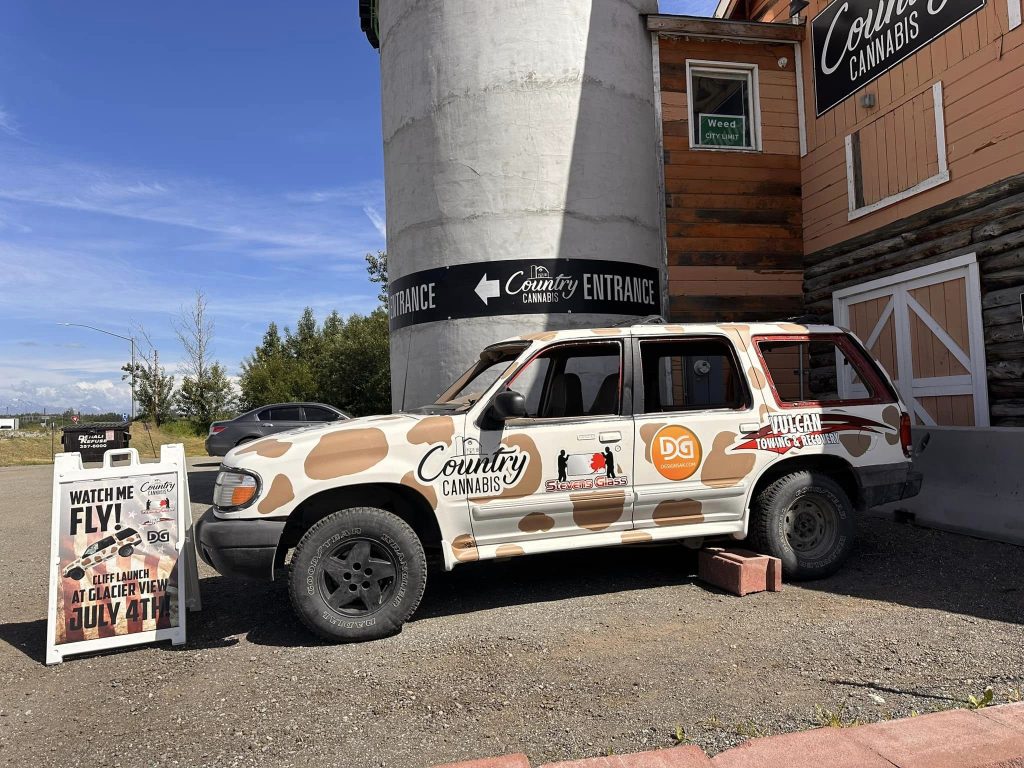Celebrating Independence with Flying Cars

Palmer, Alaska is located about a 30-minute drive from Anchorage, the state’s largest city. Palmer itself is a city of only about 6,000 people and at least one car called the “Moo Machine,” pictured above. It’s a vehicle used by a cannabis dispensary in Palmer, and well, that’s really all I know about it. That, and by this time next Friday, it will be a wreck.
Why? Because it’s going to fly. And because flying cars don’t exist yet, the landing is going to be a doozy.
Palmer is located about an hour’s drive from Glacier View, Alaska (here’s a map), a community of about 350 people on most days of the year. But on the Fourth of July — America’s Independence Day — Glacier View gets a lot of visitors. That’s because its Independence Day celebration is unique. While many municipalities launch fireworks in the air while the crowd gathers on the beach below to watch, that won’t work in Alaska — the sun doesn’t go down until almost midnight in July, and that’s too late for most families to enjoy such a spectacle. So, Glacier View eschews the flame and sparklers for metal and rubberized tires. They fire cars into the skies.
Welcome to the Glacier View Fourth of July Car Launch. Let’s start with a video. (The first 90 seconds show the surrounding scenery, and it’s gorgeous, but if you want to cut the action, fast forward to about 1:40 in.)
The event, as you can see from the video, draws a few thousand fans and a bunch of destroyed vehicles. As Car and Driver explains, “the Glacier View Fourth of July Car Launch began in 2005, according to [co-founder Arnie] Hrncir, and it started in a way that can only happen in Alaska. In 2003, his wife hit a moose in their Volvo, and eventually, he got tired of working on the car. What to do with a totaled Volvo? Put a rock in the trunk and run it off a cliff. Obviously.”
Lots of friends and family came to watch the moose-wrecked Volvo meet its ultimate doom at the hands of gravity, and Hrncir realized that he had a crowd pleaser on his hands. The event has become an annual tradition since — and its popularity hasn’t waned. According to a summary of this year’s event, last year, the parking lot opened at 8:30 am and filled within an hour and a half, even though the first car launch wasn’t until 2 pm. (And this is probably one of those events where you want to park in the official parking lot — you don’t want your car mistaken for a show vehicle!) Tickets cost $20 and if you want to see it live, that’s your only way — the event isn’t livestreamed. But if you do attend, you’ll see more than flying cars. Per Alaska.org, the festivities include “a flyover of Kingdom Air Corps planes, a parade, community bbq (bring your own meat to grill on provided grills), fireworks, and [of course!] the launching of a vehicle off a 300-foot cliff.” The vehicles are typically dressed for the occasion, too — they’re painted thematically to celebrate Independence Day, local businesses, or other cultural moments. (There’s a rumor that this year’s Car Launch will feature a Barbie-themed car, inspired by last year’s blockbuster movie.)
And while launching cars into the skies can be dangerous, safety is a primary concern. On the launch side of things, don’t worry — no drivers are needed to get the vehicles soaring. Hrncir told Car and Driver that “the system for launching the cars is completely hands-off. [ . . .] They have two launch tracks: one with a railroad track that attaches to the vehicles’ steering arm, and another one where they tie the steering wheel straight with ratchet straps and open the throttle.” And for viewers, precautions have also been taken. “Spectators gather in a designated zone at the base of the cliff, safely distanced from the impact area. A pond near the viewing area acts as an additional buffer, protecting the audience from any flying debris,” according to Yahoo.
At the end of the day, organizers load the wrecked vehicles onto flatbeds and volunteers help collect the scattered debris. All of the collected wreckage is recycled.
Bonus fact: Anchorage, Alaska, seems rather remote — only about 280,000 people live there and the surrounding areas are desolate. But it’s home to Ted Stevens Anchorage International Airport, which is the fourth busiest airport by cargo traffic in the world. That’s because it’s roughly equidistant to many major world population centers, at least as the crow (or plane, but not car!) flies. It’s a less than a ten-hour flight from New York City, Japan, and — if you go over the North Pole — much of Europe.
From the Archives: Home Sweet Apartment Building: Welcome to Whittier, Alaska, the town where everyone lives in the same apartment building.
